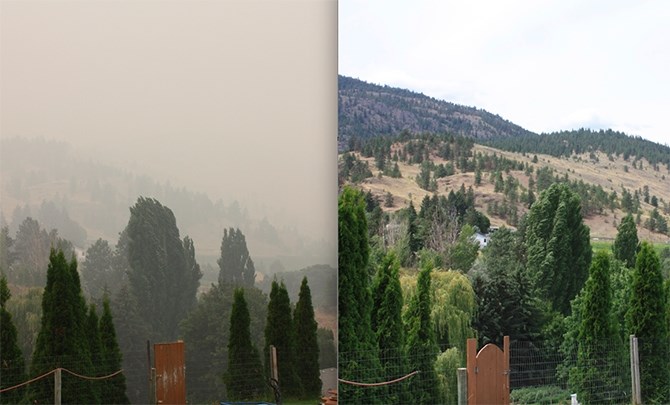
Weather forecasters are predicting a break in smoky conditions such as those experienced across the region last summer (left side of photo) at least until August.
(STEVE ARSTAD / iNFOnews.ca)
July 10, 2019 - 6:00 AM
PENTICTON - There’s good wildfire news in the Kamloops and Okanagan long range forecast for July, but all bets are off for the month of August.
Accu weather Senior meteorologist Brent Anderson says a cooler weather pattern is shaping up for the British Columbia southern interior for the mid to latter part of July that should result in slightly below normal temperatures and above normal precipitation across south and central B.C.
That's a bit of a change from a long term forecast issued earlier this year, calling for a dominant ridge of high pressure throughout June, July and August.
“It’s good news in terms of wildfire threat, although there may be more lightning,” Anderson says.
But Anderson notes higher humidity levels and more mixing of the air should be good news in terms of any wildfire smoke lingering in the region.
Towards the end of July, the situation is expected to change, Anderson says, with predictions of a high pressure ridge building over the province in a traditional summer weather pattern.
He says it’s expected August will be warm and dry, with a stagnant air pattern forming over the region that can trap wildfire smoke.
“July should offer residents a reprieve from wildfire conditions this year,” Anderson says, “August could still be a problem.”
Although the current fire rating in the Kamloops fire district is sitting at low to very low this week, that could change quickly.
June's late-month moisture means forest fire activity has been far below the record bad years of 2017 and 2018.
“On this date in 2017, we had about 550 fires and there were 18,000 hectares burned in total,” Kyla Fraser, a fire information officer with B.C. Wildfire Service, told iNFOnews.ca. “It was around this time in 2017 when things started to heat up. We had quite a lot of lightning move through and over 100 fires in one day.”
In fact, between July 6 and 8, 2017, there were 190 new fires started in B.C. and a state of emergency was called on July 7. It lasted 70 days.
With 1,351 fires burning 1.2 million hectares over the summer, that was considered the worst fire season in B.C. history.
That record was eclipsed last year when 2,117 fires burned 1.4 million hectares. A state of emergency was called Aug. 15, 2018 but only lasted 23 days.
Contrast that with this summer so far.
“There are no fires of significance right now,” Fraser said. “When we’re looking at the province, I would say, the area of most concern would be the Northwest Fire Centre. They haven’t had quite as much rain as the rest of the province so it’s quite dry up there and they did see some lightning over the past few days."
So far there have been 473 fires in the province this year, versus 550 in 2017 and 600 in 2018. But the real difference is in the size of those fires – 11,768 ha this year versus 18,000 to the same date in 2017 and 47,000 last year.
Does that mean the province is out of danger?
Not if the normal hot dry summer weather hits, as Anderson predicts.
It’s hard to predict how fast the forests will dry out.
“The speed of drying depends on the starting point in fuel moisture, the type of vegetation and then weather conditions,” Fraser said in an email. “Wind, radiation, temperature, cloud cover and humidity all impact speed of drying. A thin blade of grass is much more susceptible to drying factors than a log. An area with an enclosed canopy will also maintain moisture longer than fuels exposed to wind and sun.”
B.C. Wildfire Service has different “codes” when determining fire risk. The Fine Fuel Moisture Code measures how much moisture is in the litter on the forest floor. It can be dampened with as little as 0.5 mm of rain but can dry out in half a day.
To dry out larger fuels, it can take more than two weeks.
So far, there are no campfire bans in the Kamloops Forest District.
— with files from Rob Munro
To contact a reporter for this story, email Steve Arstad or call 250-488-3065 or email the editor. You can also submit photos, videos or news tips to the newsroom and be entered to win a monthly prize draw.
We welcome your comments and opinions on our stories but play nice. We won't censor or delete comments unless they contain off-topic statements or links, unnecessary vulgarity, false facts, spam or obviously fake profiles. If you have any concerns about what you see in comments, email the editor in the link above.
News from © iNFOnews, 2019